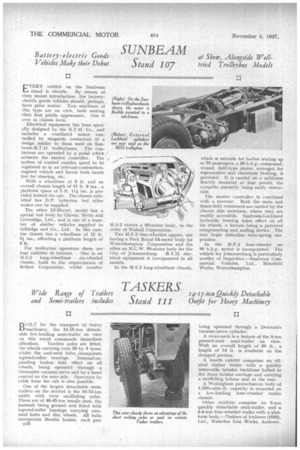TASKERS
Page 62

If you've noticed an error in this article please click here to report it so we can fix it.
Stand III
BUILT for the transport of heavy L./machinery, the 14-15-ton detachable low-loading semi-trailer on view on this stand commands immediate attention. Tandem axles are fitted, the wheels carrying twin 29 by 8 tyres, whilst the cast-steel hubs, incorporate tapered-roller bearings. Internal-expanding brakes take effect on all wheels, being operated through a Dewandre vacuum servo and by a hand control on the near side. Operation by cable from the cab is also possible.
One of the largest detachable semitrailers on the market is the 10-12-ton outfit with twin oscillating axles. These are of 40-45-ton tensile steel, the journals being ground and fitted with tapered-roller bearings carrying caststeel hubs and disc wheels. All hubs . incorporate I3endix brakes, each pair D:38 being operated through a Dewandre vacuum-servo cylinder. • A swan-neck is a feature of the 8-ton pressed-steel semi-trailer on view. With an overall length of 20 ft., a length of 14 ft. is available on the dropped portion. • A fourth exhibit comprises an all-. steel timber trailer with a quickly removable tubular backbone bolted to the front bolster carriage and carrying a swidelling bolster unit at the rear. .
A Wokingham pantechnicon body of 1,050-cubic-ft. capacity is mounted on a low-loading four-wheeled trailer chassis.
Other exhibits comprise an 8-ton quickly detachable semi-trailer, and a 5-6-ton four-wheeled trailer with a platform body.—Taskers of Andover (1932), Ltd., Waterloo Iron Works, Andover.


















































































